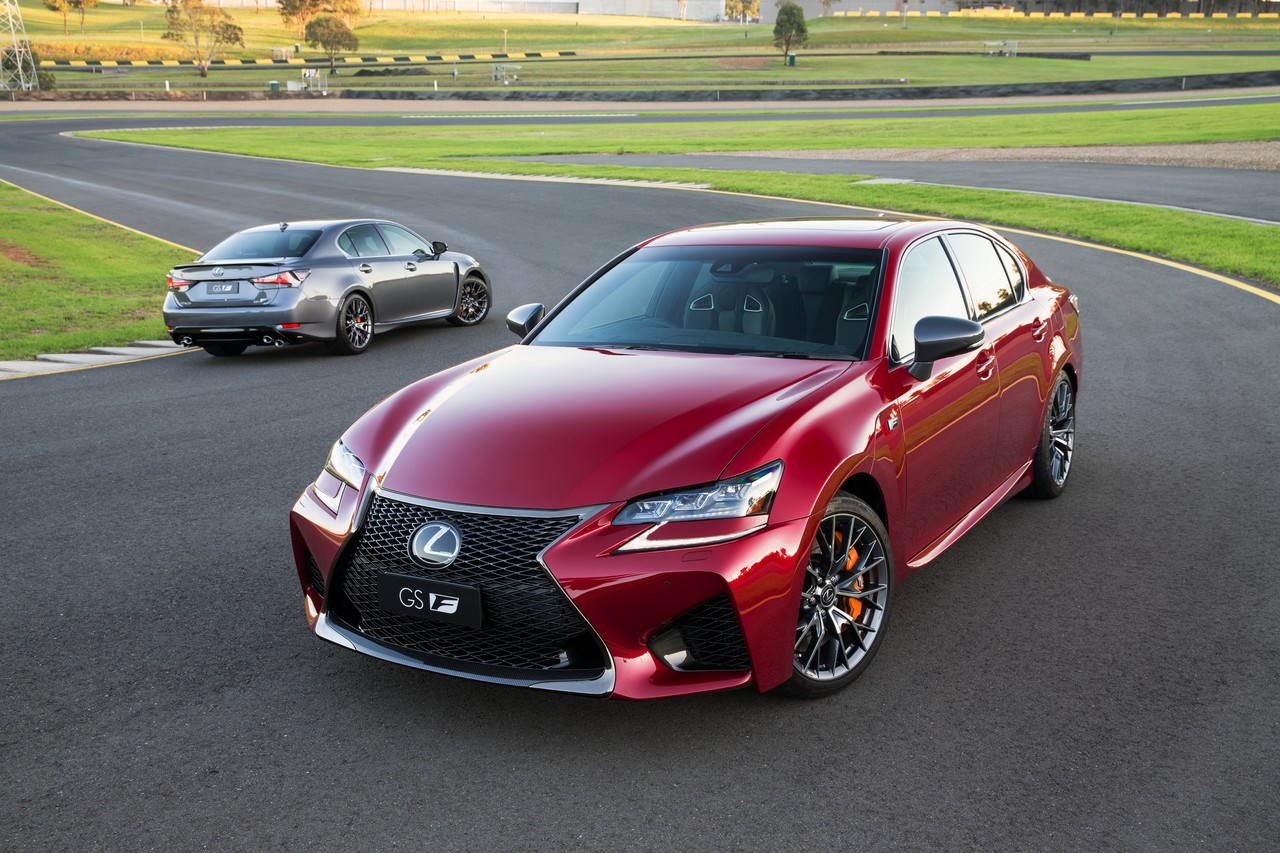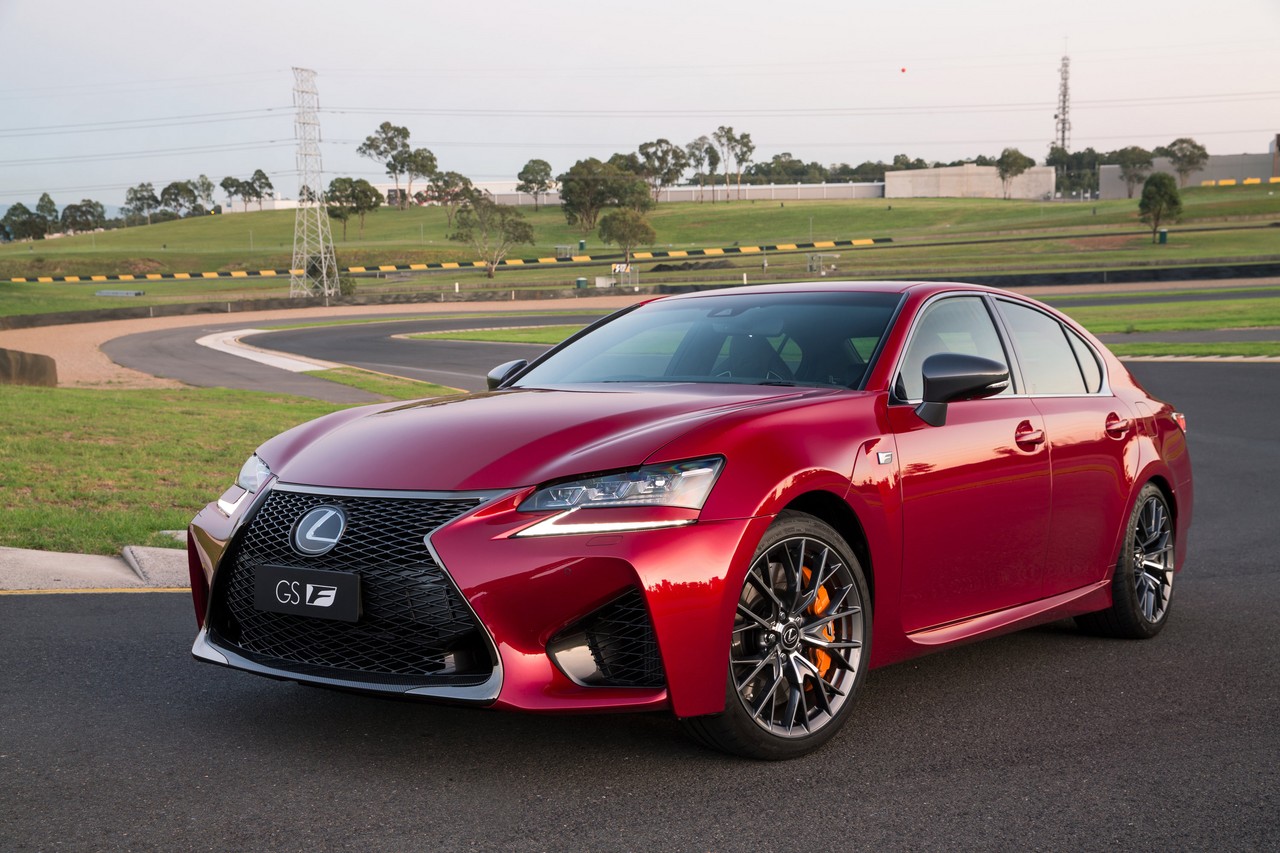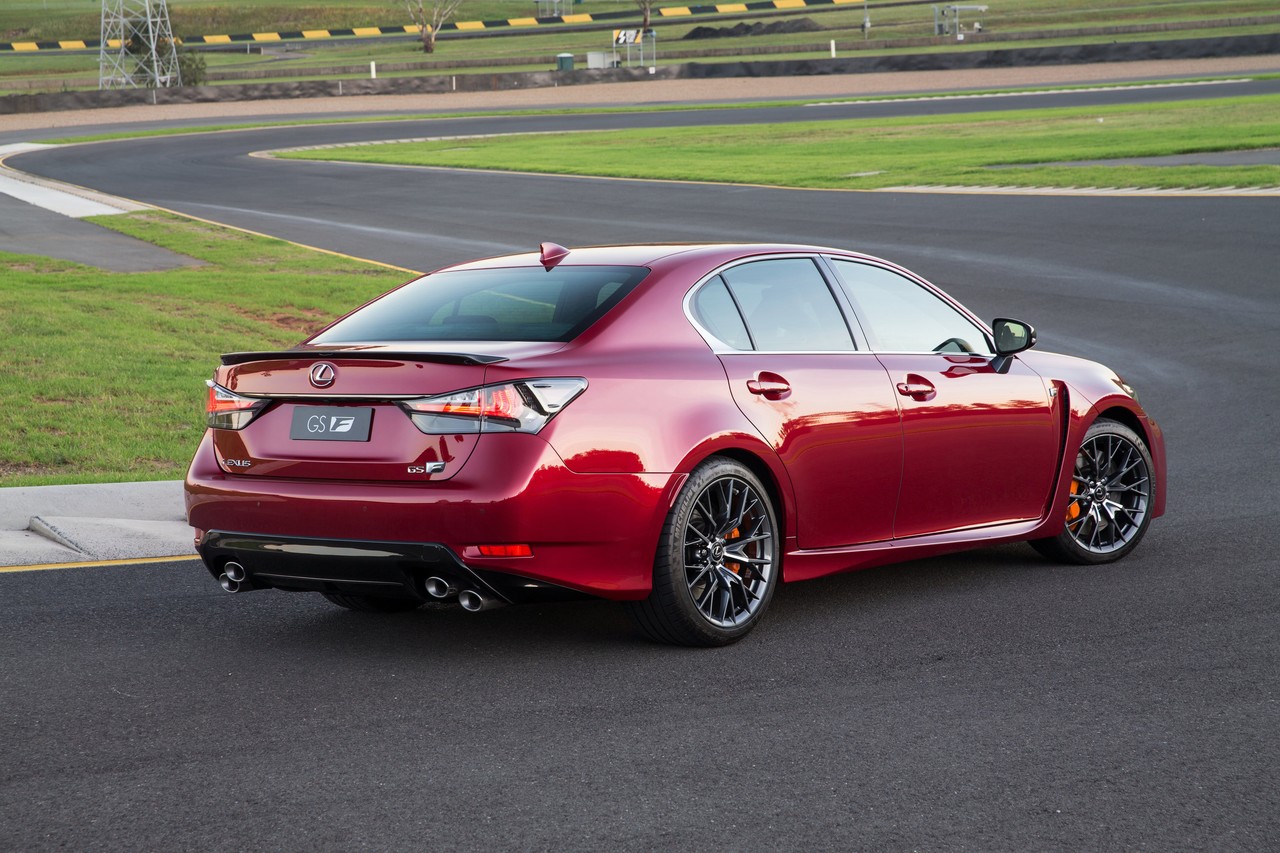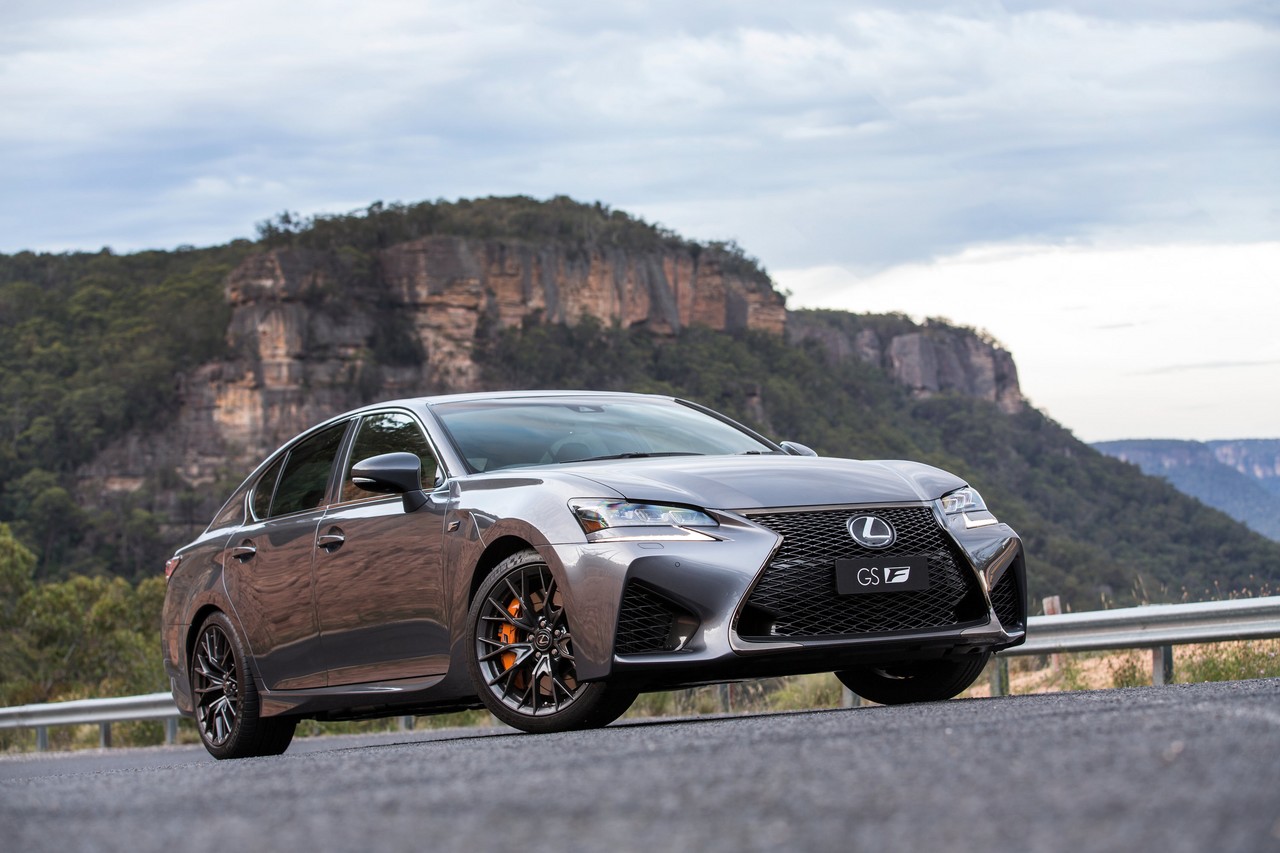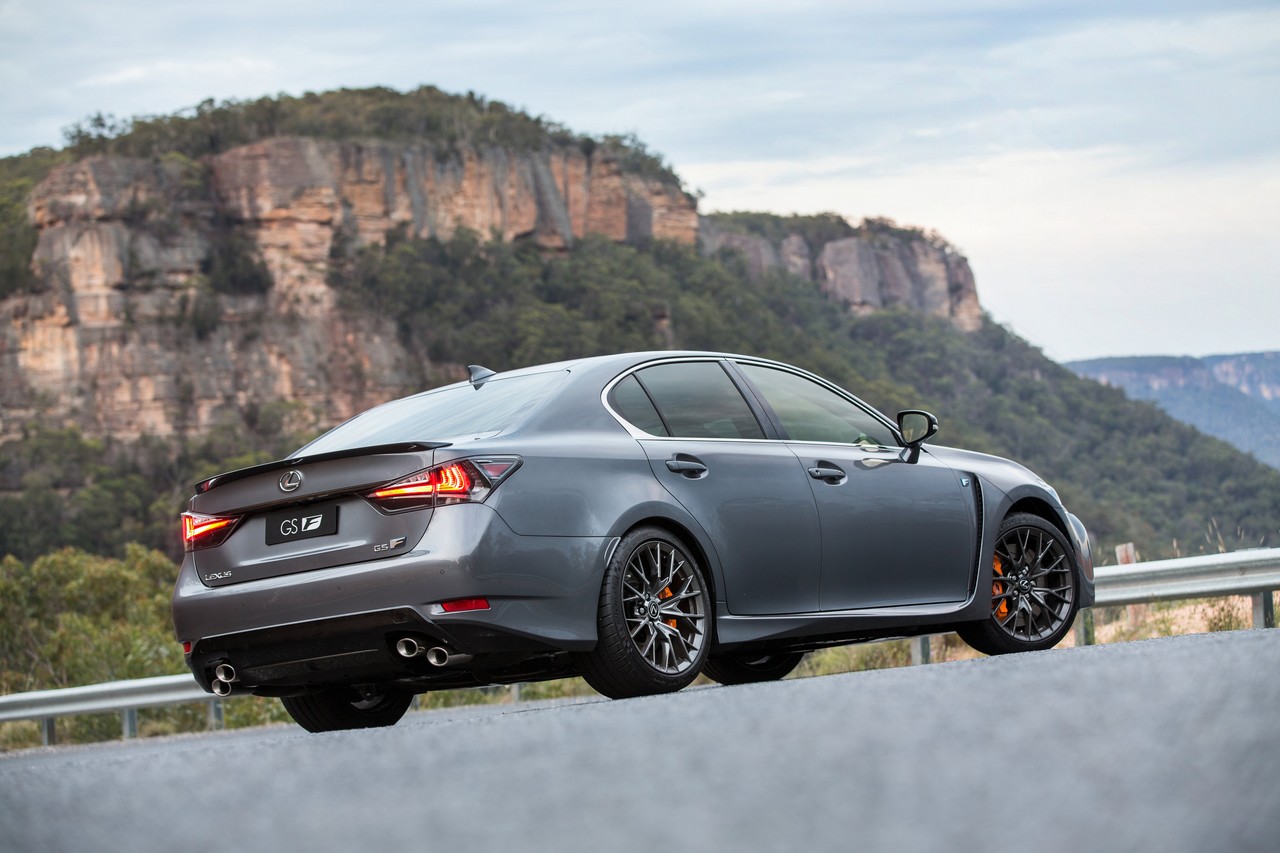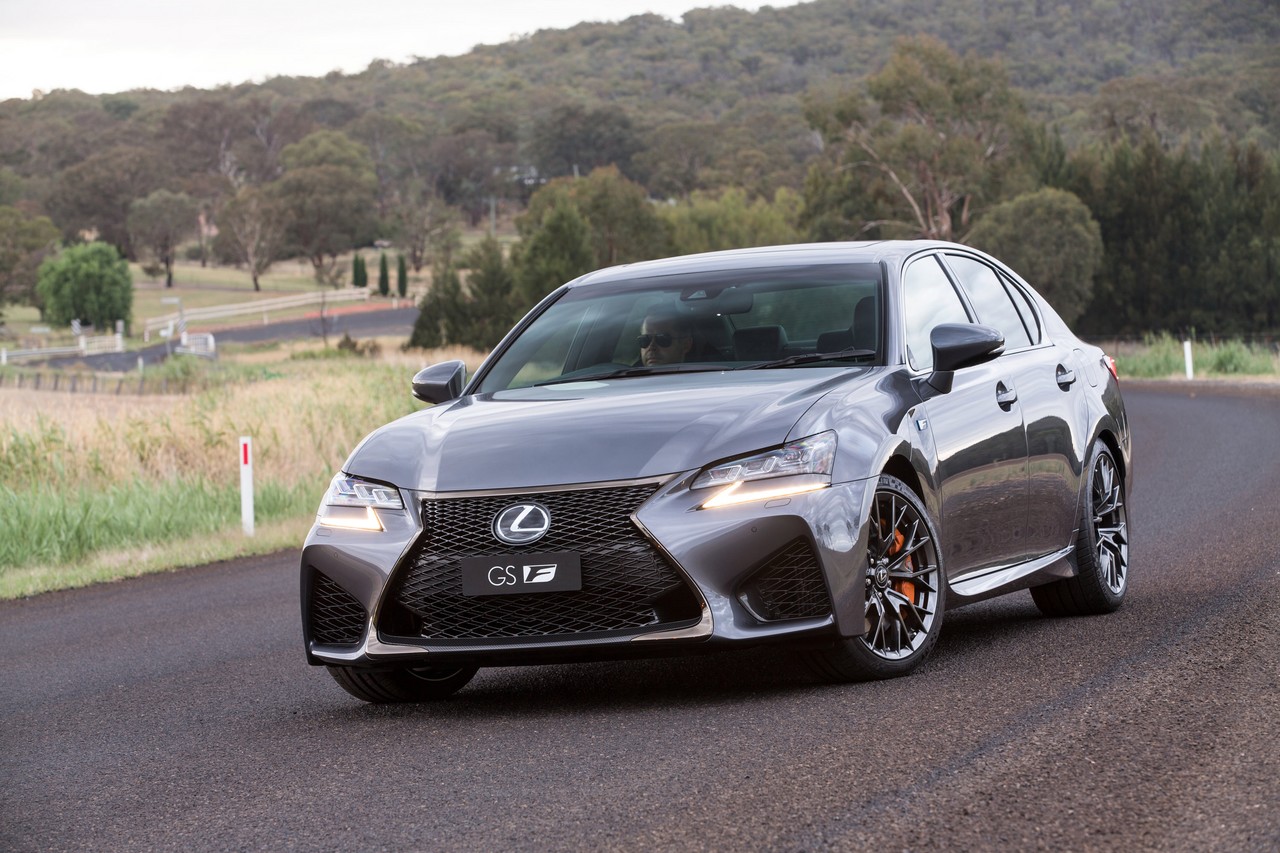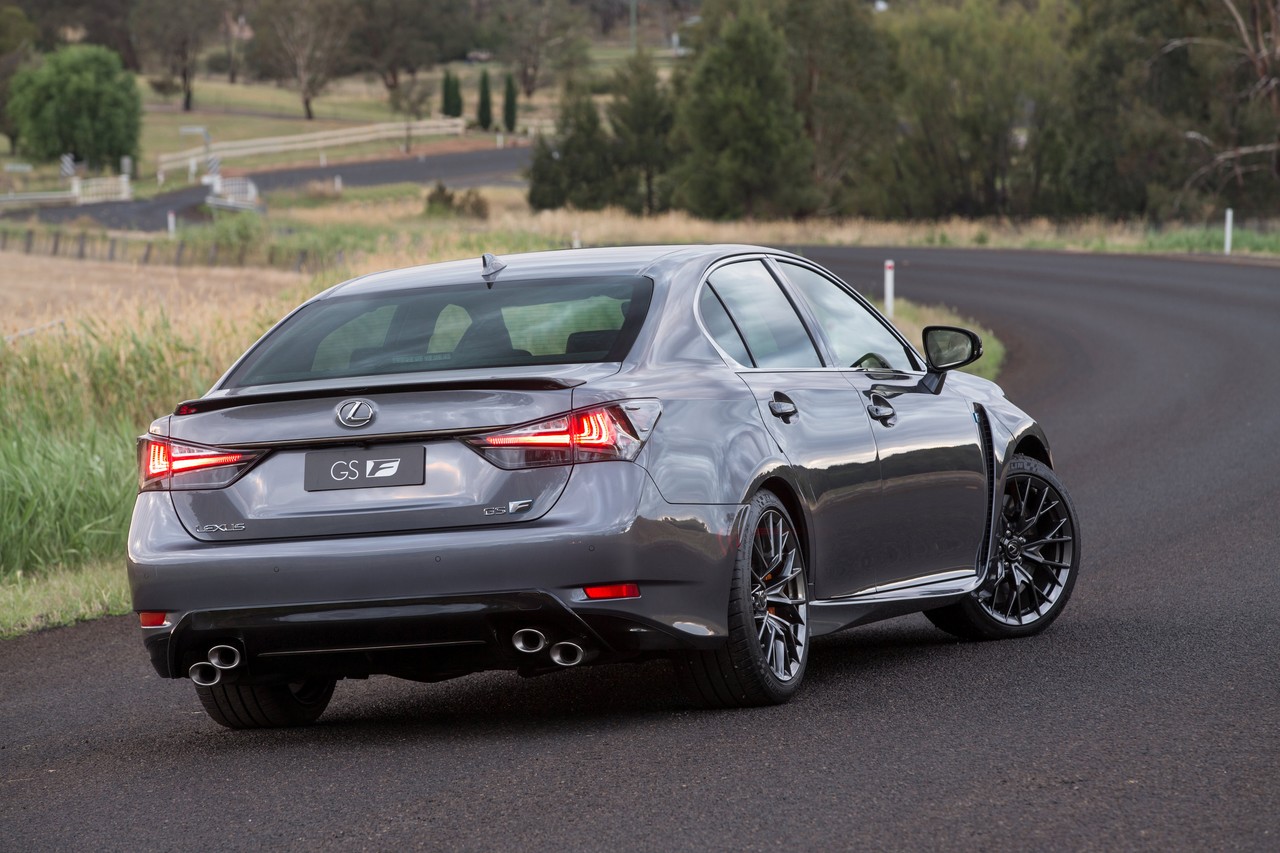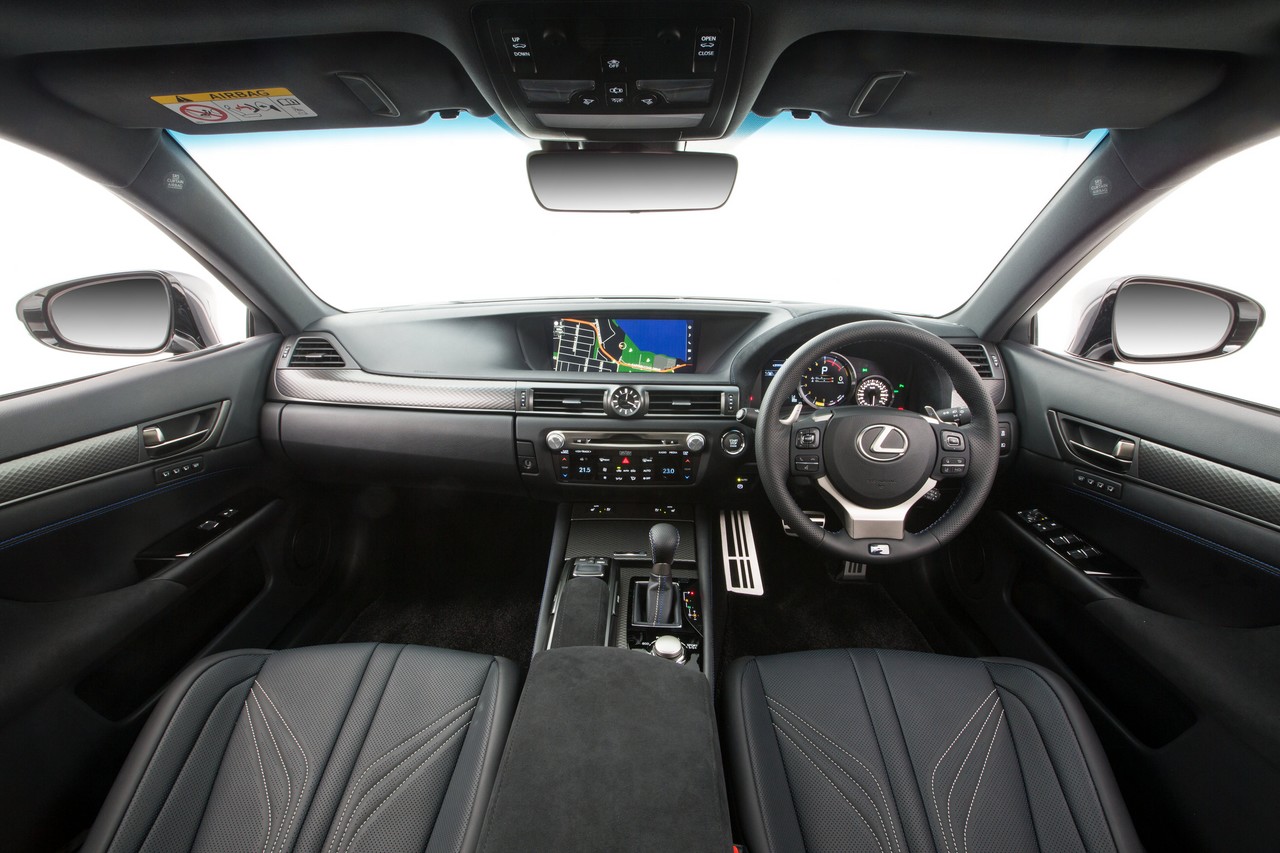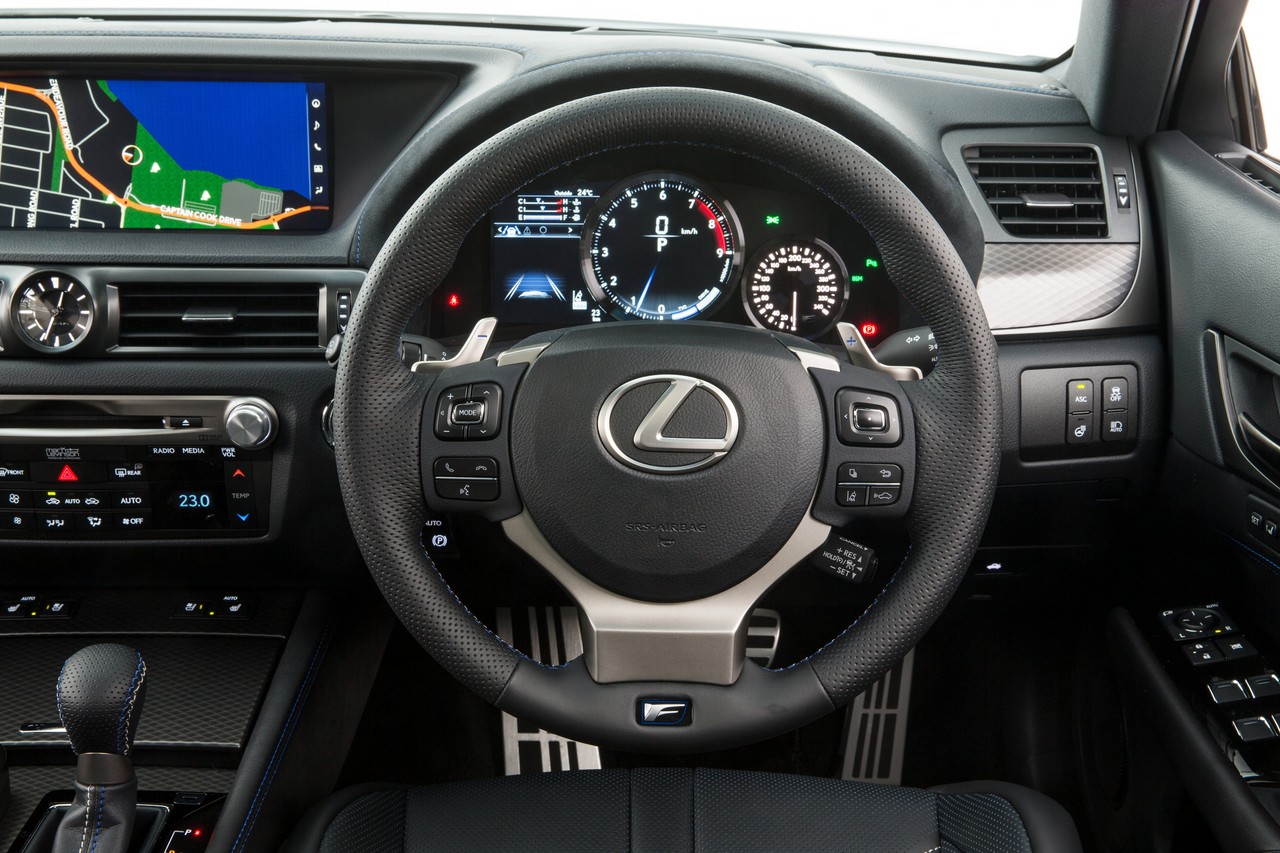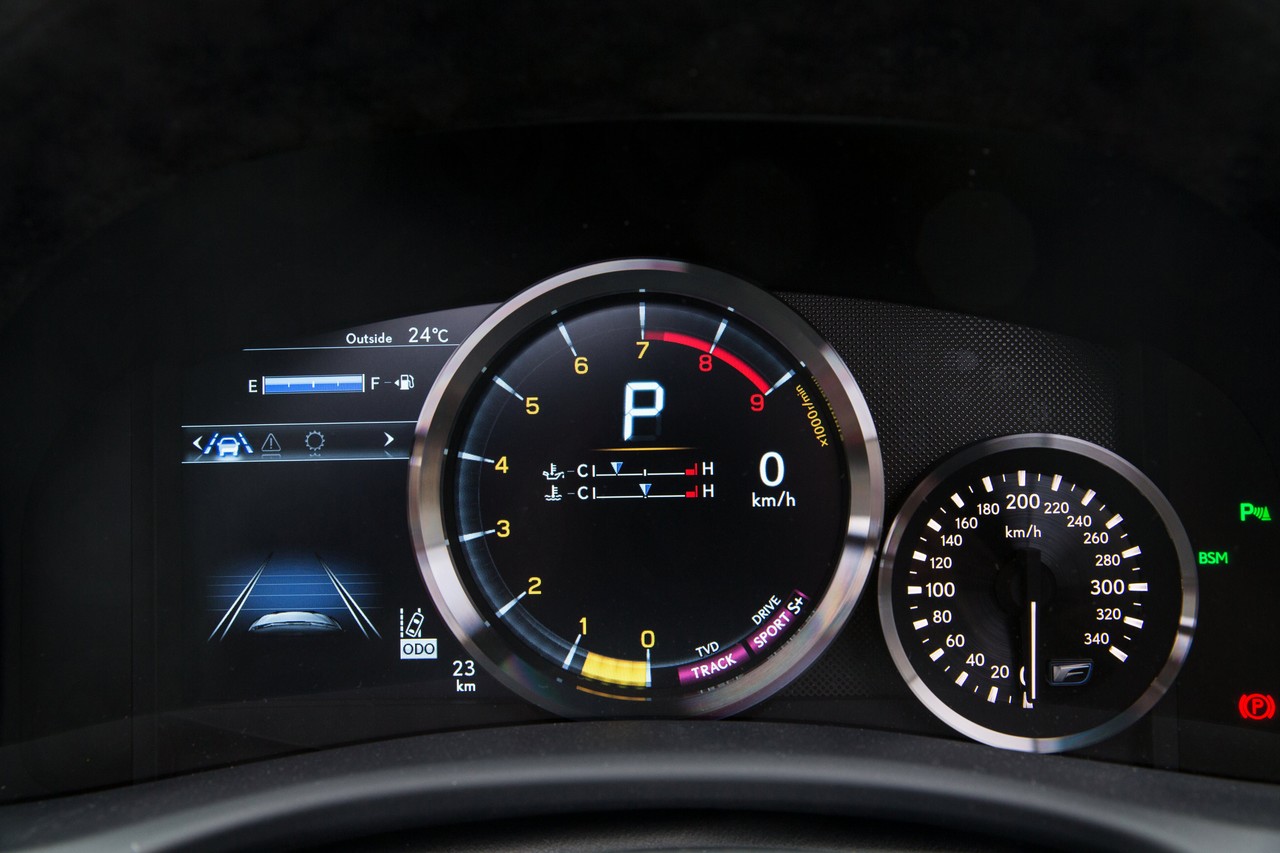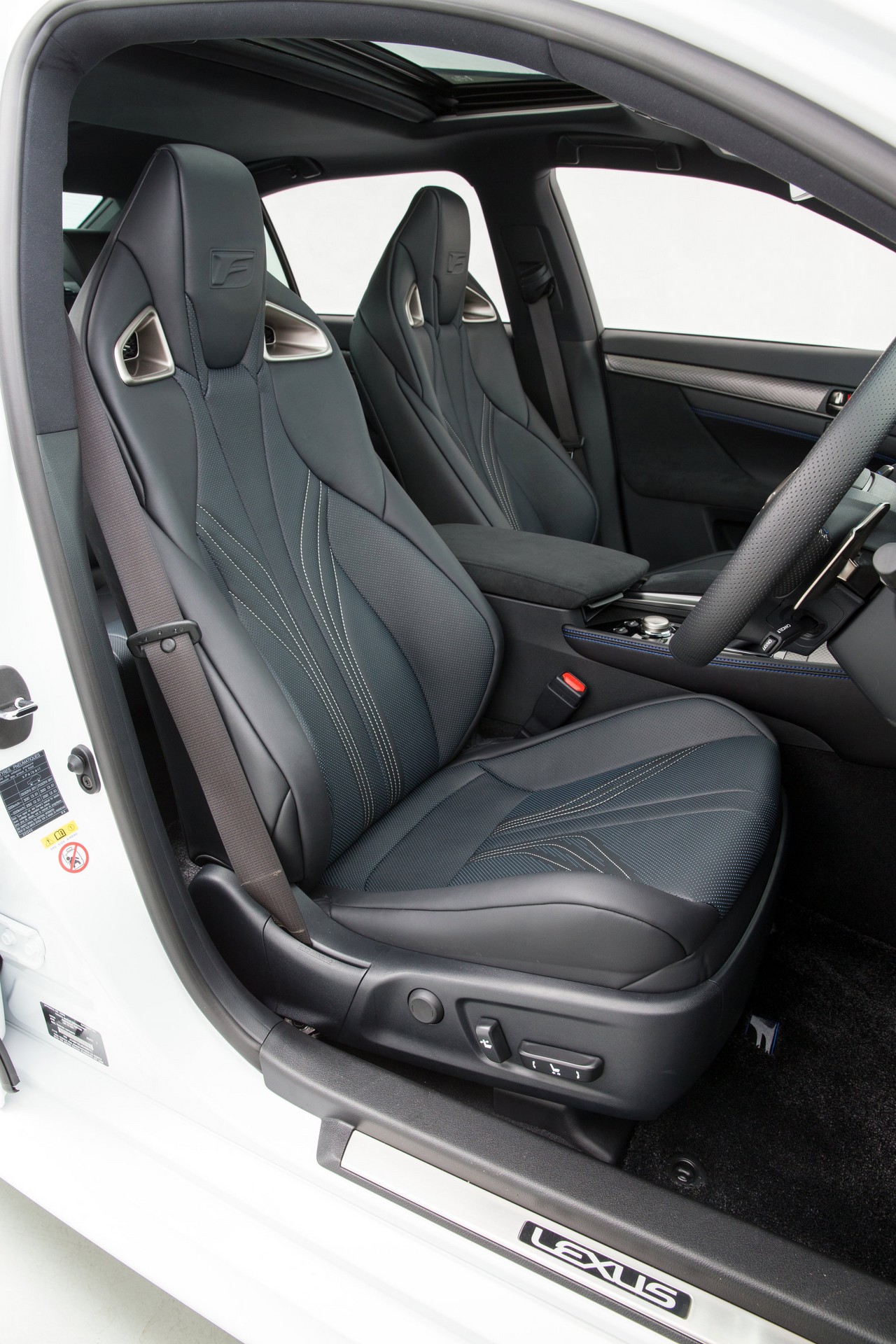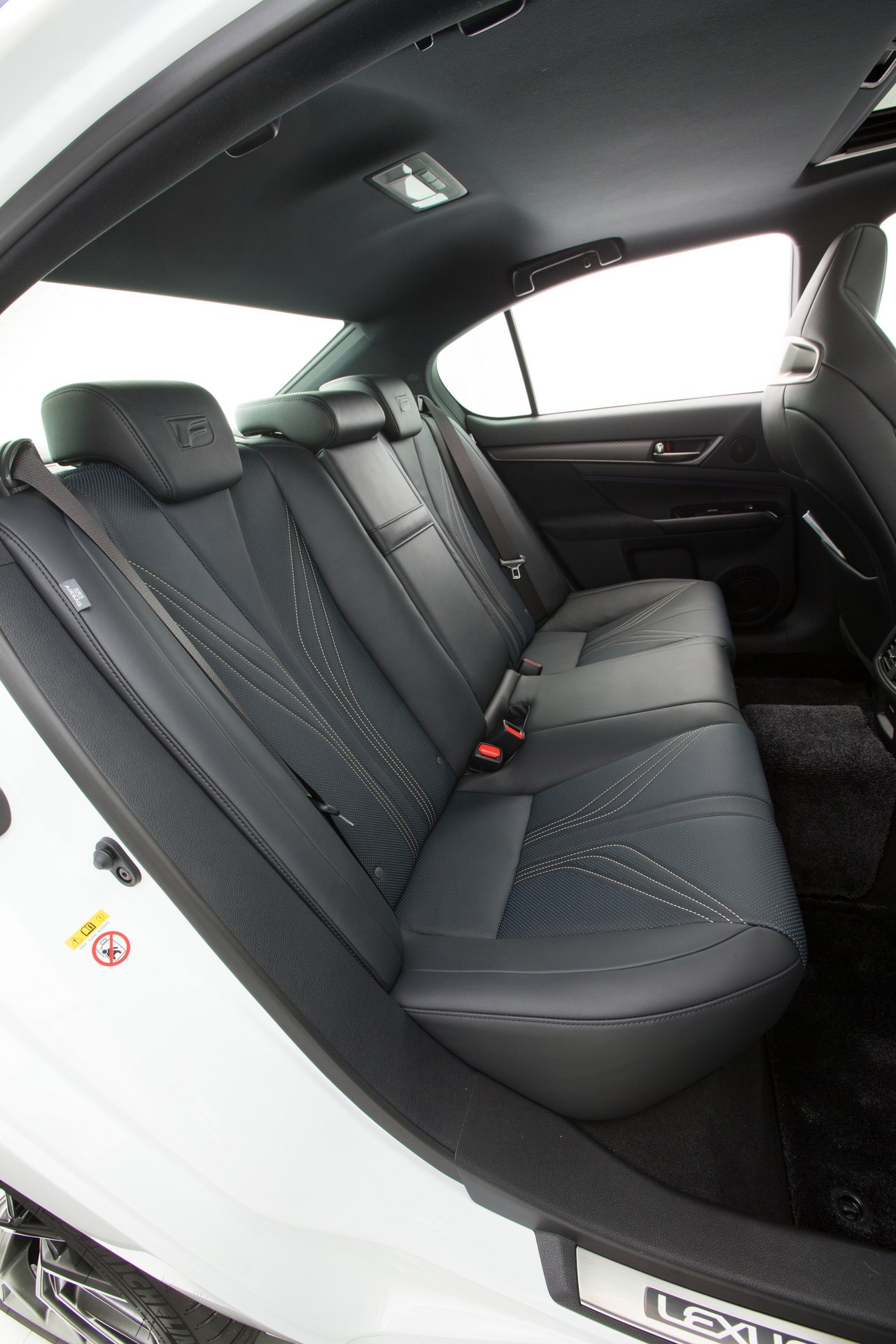
- Free-revving 5.0-litre 2UR-GSE V8 engine
- Rigid chassis
- High standard of interior fit and finish
- Quiet and refined interior
- Engine lacks mid-range torque of turbocharged rivals
- Steering feel?
Overview
Commencing production in late 2015 and officially released in Australia in February 2016, the Lexus L10 GS F was a high-performance sedan. Manufactured in Tahara, Japan, the rear-wheel drive Lexus GS F is powered by a 5.0-litre V8 petrol engine that was mated to an eight-speed automatic transmission.
2UR-GSE V8 engine and transmission
Like the Lexus RC F , the GS F was powered by the 4969 cc 2UR-GSE V8 petrol engine which had a die-cast aluminium block, aluminium heads, magnesium cylinder covers, titanium inlet valves, double overhead camshafts per cylinder bank, four valves per cylinder, variable intake and exhaust valve timing (‘Dual VVT-i’), VVT-iE camshaft timing (i.e. an electrically-operated actuator controlled intake camshaft timing, whereas exhaust camshaft timing used a conventional hydraulic actuator), a two-stage intake system and a compression ratio of 12.3:1. The intake and exhaust camshafts could be adjusted over a range of 56 degrees and 30 degrees, respectively, relative to the crankshaft.
The 2UR-GSE engine had a twin injection fuel system (‘D-4S’) which combined direct injection with traditional port injection (the latter for more precise air/fuel mixing under low and medium load conditions). The 2UR-GSE engine operated on an Atkinson cycle at cruising speeds for improved fuel economy and an Otto cycle at higher speeds for greater power. Furthermore, the 2UR-GSE engine had a 7300 rpm redline and required 98 RON premium unleaded petrol.
The Lexus GS F could accelerate from rest to 100 km/h in 4.6 seconds; its top speed was electronically limited to 270 km/h. Over the combined ADR 81/02 test cycle, fuel consumption was 11.3 litres per 100 km.
| Engine | Trans. | Peak power | Peak torque | |
|---|---|---|---|---|
| GS F | 5.0-litre petrol V8 (2UR-GSE) | 8sp auto | 351 kW at 7100 rpm | 530 Nm at 4800-5600 rpm |
AA80E transmission and drive modes
The Lexus GS F was fitted with an eight-speed Sports Direct Shift (SPDS) automatic transmission (Lexus’ AA80E) and had steering wheel paddles for sequential shifts. For sequential shifting in ‘M’ mode, the transmission could adopt full torque converter lock-up from second to eighth gears, while up and downshifts could be performed in 0.3 and 0.2 seconds, respectively. Furthermore, the transmission used information from two g-sensors to determine which gear to use when driving on winding roads.
The Lexus GS F had four selectable drive modes: Normal, Eco, Sport S and Sports S+ (the latter designed specifically for race track driving). For Sport S and Sport S+, an Acceleration Sound Control (ASC) function used the vehicle’s sound system to amplify the engine note.
Body and dimensions
While the GS F shared its platform with the Lexus L10 GS , the GS F had more high-strength steel (41.9 per cent high-tensile strength steel, including steel up to 980 MPa tensile strength in the underbody), greater use of body bonding adhesives, laser-screw welding and spot welding. The GS F also had additional front and rear body braces (including a closed-section front brace) and new mounts for the rear suspension.
Compared to the Lexus L10 GS , the GS F was 65 mm longer (at 4915 mm), 5 mm wider (1845 mm with mirrors folded), 15 mm lower (1440 mm) and had the same 2850 mm long wheelbase. Furthermore, the Lexus GS F had a kerb weight of 1825 kg to 1865 kg (depending on specification) and a 520 litre boot.
Suspension
The Lexus GS F had double wishbone front suspension with forged aluminium upper and lower arms. At the rear, the GS F had multi-link independent rear suspension, with a forged upper arm number 1 and rear lower arm number 2. Both the front and rear suspension utilised coil springs, ZF Sachs monotube dampers and stabiliser bars.
From November 2016, however, the Lexus GS F was equipped with Lexus’ Adaptive Variable Suspension (AVS) which consisted of electronically-controlled dampers that adjusted damping forces according to inputs from sensors measuring G-force, steering input, yaw rate and wheel speed. According to Lexus, AVS had seven damping-force control strategies – including anti-dive and anti-squat – and provided 30 levels of damping force. When Eco, Normal or Sport S modes were selected via the Drive Mode Select system, AVS prioritised ride comfort; in Sport+ mode, however, AVS prioritised handling stability.
Steering
The Lexus GS F had rack-and-pinion steering with electric power assistance; the steering had a ratio of 14.0:1 and required 2.84 turns from lock to lock. Furthermore, the Lexus GS F had a turning diameter of 11.2 metres.
Safety equipment
Standard safety equipment for the Lexus GS F included dual front airbags, driver and front passenger knee airbags, front and rear side airbags, full-length curtain airbags, ABS, electronic brake force distribution, brake assist, electronic stability control, traction control, active front seat head restraints and front seatbelts with pretensioners and load limiters.
The GS F was fitted with the Lexus Safety System+ which included:
- Lexus’ Pre-Collision Safety (PCS) system: operating at speeds above 30 km/h, the PCS used a millimetre-wavelength radar sensor in the grille to monitor the road ahead. The PCS system included pre-collision warnings (audible and visual), brake assist preparation, autonomous braking in emergency situations, retraction of the front seatbelts and airbag deployment preparation;
- Active Cruise Control (ACC): used a millimetre-wave radar to detect vehicles ahead and determine their speed. Active Cruise Control could then adjust vehicle speed – within a set range – to maintain a safe distance between the vehicles;
- Lane Departure Warning (LDW) and Lane Keeping Assist (LKA): used a millimeter-wave radar and camera to monitor the vehicle’s position within its lane. If the driver unintentionally drifted out of their lane, LDW provided a warning via steering wheel vibrations and an audible tone. If ACC was active, Lane Keeping Assist (LKA) could apply counter-steering to keep the GS F within its lane;
- A Blind Spot Monitor (BSM): once the vehicle exceeded 40 km/h, sensors in the rear bumper could detect vehicles in the adjacent lanes. If the driver indicated to change lanes and a vehicle was detected, a warning tone would sound. The BSM could detect vehicles larger than an average 125 cc motorcycle and where the relative speed difference was up to 28 km/h; and,
- Rear cross-traffic alert: when reversing at speeds below 8 km/h, sensors in the rear bumper could detect approaching traffic travelling at speeds from 8 km/h to 28 km/h which may cross the driver’s intended path. If crossing traffic was detected, a warning tone would sound.
Vehicle Dynamics Integrated Management (VDIM)
For the Lexus GS F, the Vehicle Dynamics Integrated Management (VDIM) system controlled the electronic stability control system and enabled the driver to select the following modes:
- Normal: for sedate driving and a high degree of active safety;
- Sport: gave priority to driver control, permitting a higher threshold for intervention by the electronic stability control (ESC) system; and,
- Expert: disabled the traction control system, provided a high threshold for ESC intervention and controlled the engines and brakes to assist the driver in spin avoidance manoeuvres.
Brakes
The Lexus GS F had 380 mm by 34 mm ventilated and slotted front brake discs with six-piston Brembo aluminium monoblock calipers and 345 mm by 28 mm ventilated rear discs with four-piston Brembo aluminium monoblock calipers.
Features: Lexus GS F
For Australia, standard features for the Lexus GS F included 19-inch machine-finished multi-spoke forged alloy wheels, 255/35 ZR19 92Y front and 275/35 ZR19 96Y rear Michelin Pilot Super Sport tyres, a 12.3-inch Electro Multi Vision (EMV) touchscreen for navigation, audio, climate and telephone functions, a Mark Levinson surround system with a Class D 835-watt amplifier and seventeen speakers which incorporate GreenEdge technology, DAB+ digital radio, a CD/DVD player, auxiliary inputs (3.5mm/USB/iPod) and Bluetooth audio streaming, three-zone climate control air conditioning, sport bucket seats with Alcantara trim, heated seats (front and rear), cruise control, LED headlights with washers, automatic headlights, rain-sensing wipers, front and rear parking sensors, a reversing camera with guidelines (Lexus’ ‘Back Guide Monitor’), Parallel Parking Mode, a colour head-up display (HUD), a heated leather steering wheel, steering wheel gearshift paddles, remote central locking with key card, power windows and heated mirrors with folding function, a height and reach adjustable steering wheel, driver’s seat and mirror memory settings, an electrochromatic rear-view mirror, moonroof, tyre pressure monitoring, ambient lighting, a trip computer, alarm and immobiliser.
The ‘high grade’ Lexus GS F was distinguished by its semi-aniline leather-accented seat trim and ventilated front seats.
Torque Vectoring Differential
Like the RC F, the GS F had a torque vectoring differential which offered three selectable modes:
- Standard: for a balance of agility and firmness;
- Slalom: for nimble steering response and agility; and,
- Track: for stability in high-speed circuit driving.
2018 Lexus GS F 10th Anniversary
The Lexus GS F 10th Anniversary model was released in Australia in August 2018 to commemorate the 10th anniversary of Lexus’ ‘F Line’ models. Visually, the Lexus GS F 10th Anniversary model could be identified by its ‘Fuji Graphite’ (matte grey) paint finish, carbon-fibre lower grille surround, black polished alloy wheels, ‘Competition Blue’ brake callipers and rear lip spoiler. The Lexus GS F 10th Anniversary model was also fitted with front ‘performance’ dampers for greater steering stability.
Inside, the Lexus GS F 10th Anniversary model featured a ‘Competition Blue’ interior, which included blue semi-aniline leather front sports seats with white accents and an embossed ‘F’ symbol in the integrated head restraints, blue leather trim (for the steering wheel, gearshift knob, instrument panel, centre console and seatbelts) and carbon-fibre highlights (for the window control surrounds). Furthermore, each 10th Anniversary model was fitted with a metal plaque.
Paint finishes
For Australia, the Lexus GS F was offered in Lava Mica, Cobalt Mica, White Nova, Sonic Silver, titanium, Mercury Grey, Graphite Black and vermillion paint finishes.
Brochure
Related links
- Lexus Australia: Lexus GS F Press Kit (February 2016)
- Lexus GS F Global Launch Press Kit (October 2015)
- Wikipedia.org: Lexus L10 GS
